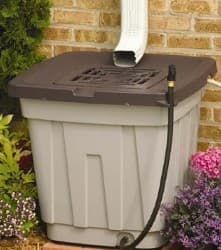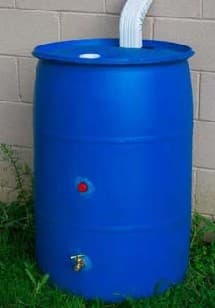Collecting Rainwater with Rainbarrels

About Rainbarrels
Some areas of the country have plenty of water. Other areas are arid, and water is a scarce and valuable commodity. If you live in an arid region of the country, you may want to use a rainbarrel to collect and store rainwater. In addition, gardeners all over the country, often collect pure, clean rainwater to irrigate their gardens. They know that water out of the tap is treated with chemicals, most notably chlorine and fluoride. The organic gardener will have none of this.
Rainwater collection, or rainwater harvesting as some call it, is becoming increasingly popular, as the demand for fresh water supplies increases in many parts of the country.
Rainwater collection is easily accomplished by, capturing the rain that falls onto your roof. The rain falls into the gutters, then it travels through the downspout. A rain barrel at the bottom captures runoff for future use. The effects of extreme, extended drought in the West, make the use of rain barrels important in these areas of the country.

What to Look for in a Rainbarrel
Almost any barrel or bucket can be used to capture rainwater. A good rain barrel will have the following features:
It is sturdy
It is long-lasting
A lid that latches, to keep children and pets safe.
There should be a screen or debris filter at the top, to keep leaves and other debris out.
Look for a drain hose at the bottom, and a shut-off valve for the drain.
Expandable – can be linked to another barrel, as your need grows.
Plants Grown as Cover Crops
By definition, cover crops are any plants grown to help improve or retain the soil. Technically, this means you can use any plant. However, some plants are better than others. Of important note, select annual plants. When they are tilled into your garden soil, they won’t grow back to choke out your garden plants. Some plants return a higher amount of nutrients, especially nitrogen to the soil.
Cold weather plants are also preferred, as they will grow the best in fall and winter (depending upon your region) weather.
The best cover crops are:
- Clover – Crimson clover is one of the best cover crops.
- Hairy Vetch, is an excellent choice.
- Cereal grains
- Annual Ryegrass – grows well in cool weather
- Legumes work well to “fix” nitrogen in the soil. They include beans, peas, and soybeans.
Did You Know? As an alternative, use mulch in the home garden, to provide many of the same benefits as a cover crop. More on Garden Mulch.
Related Articles
People who like this article will also like:
Winter Gardening – There are gardening tasks you can perform in the winter.
Improving Garden Soil – Fall is a great time to improve your soil. Find out how.
Please support our site. Shop for:
- rmmatthews100@hotmail.com
- 585-721-6528
- Rochester, NY
©1999-2024 GardenersNet.Com, All Rights Reserved

